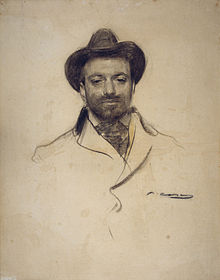José Maria Sert
| Josep Maria Sert | |
|---|---|

Sert seen by Ramon Casas (MNAC)
|
|
| Born |
Josep Maria Sert i Badia 21 December 1874 Barcelona, Spain |
| Died | 27 November 1945 (aged 70) Barcelona, Spain |
| Resting place | Vic Cathedral |
| Nationality | Spanish |
| Known for | Murals |
| Style | Grisaille |
| Movement | Baroque |
| Spouse(s) |
Misia Godebska (m. 1914; div. 1927) Isabelle Roussadana Mdivani (m. 1928; d. 1938) |
Josep Maria Sert i Badia (Catalan pronunciation: [ʒuˈzɛb məˈɾi.ə ˈsɛrt]) (Barcelona, 21 December 1874 – 27 November 1945, buried in the Vic Cathedral) was a Spanish muralist, the son of an affluent textile industry family, and friend of Salvador Dalí. He was particularly known for his grisaille style, often in gold and black.
Sert initially studied art in Rome before moving to Paris in 1899. There, he became involved with a group of decorative artists known as Les Nabis, gravitating around Paul Ranson, who had studied at the renowned private Académie Julian, founded in 1868 by painter Rodolphe Julian.
Sert was commissioned in 1900 to paint several murals at the Vic Cathedral in Barcelona, which took him more than 30 years to complete.
By 1910, Sert had begun fully focusing on murals and other large-scale work. He collaborated with Russia Sergei Diaghilev to create sets for his Ballets Russes. In the United States, Sert painted a mural at the Waldorf-Astoria in New York City, as well as a 1937 mural entitled American Progress at 30 Rockefeller Center.American Progress was commissioned by the Rockefellers to replace Diego Rivera’s mural Man at the Crossroads, which Nelson Rockefeller destroyed because it included an image of Lenin.
...
Wikipedia
